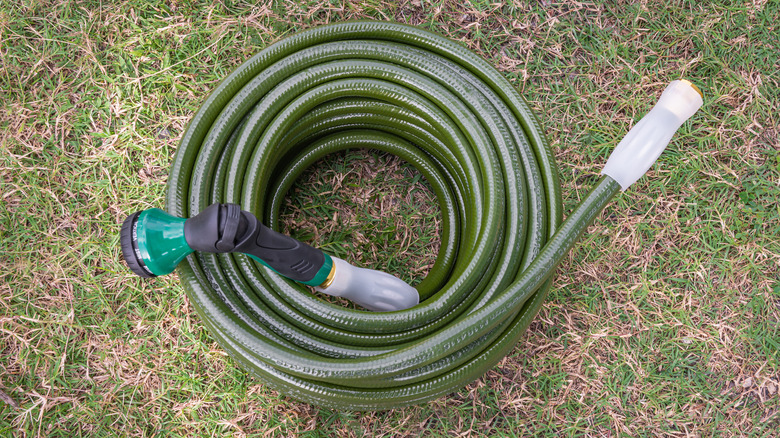How To Drain A Hose: And Why You Must Before The First Frost
Before winter's freezing temperatures and snow roll in, there's plenty that homeowners have to do to prepare for the cold weather. Chores like scheduling a tune-up for your heating system, installing storm doors and windows, and applying weatherstripping or caulk where necessary make most people's winterizing to-do list, but there is one area that many overlook: their garden hose. Draining your hose before the first frost is essential if you want to avoid a big plumbing headache — and you'll hate yourself if you let your pipes burst in winter by forgetting this task. Fortunately, the process is pretty simple: turn off the water supply, let the remaining water in the hose drain, and then disconnect it for storage.
It's important to drain your garden hose before the temperature hits freezing to avoid damage to both the hose itself and your pipes. Typically, your pipes aren't in danger of freezing until the temperature is around 20 degrees Fahrenheit for several hours, but the hose can freeze more easily. If water is still inside the hose, it can freeze in as little as six hours at temperatures below 32 degrees Fahrenheit. As the ice expands, the hose can burst. However, a frozen hose also puts the faucet, spigot, and internal pipes that it's connected to at risk. If the ice pushes back into the hose's connections, then those components can also burst, leading to a very expensive plumbing bill.
Here's how to drain and store your hose for winter
The first step in draining your hose is to shut off the water supply to the outdoor faucet it's connected to. If you're not sure where it's located, most shutoff valves are located on the opposite side of or very close to the faucet, but inside your home. That often means the basement, but check near your water meter if you're having trouble locating it.
With the water turned off, go back outside to disconnect the hose from the spigot. Open the outdoor faucet as far as it will go, and allow any water still inside the pipe to drain out. Let the water run until no more comes out of the faucet, then close it. This process ensures that no water remains in the interior pipes, which might freeze when temperatures drop.
Next, remove the spray nozzle and any other attachments from your hose. To drain the hose, set one end over the top of a tall fence or railing to lift one end high above the other. Any water still inside will flow out, so you don't have to worry about the hose freezing and cracking.
Storage mistakes can make your hose's lifespan shorter, so take the time to carefully coil it in 18" to 24" loops, so there are no tangles or kinks. It's best to keep your drained hose indoors during the winter. Your garage, shed, or basement is an ideal storage spot .

